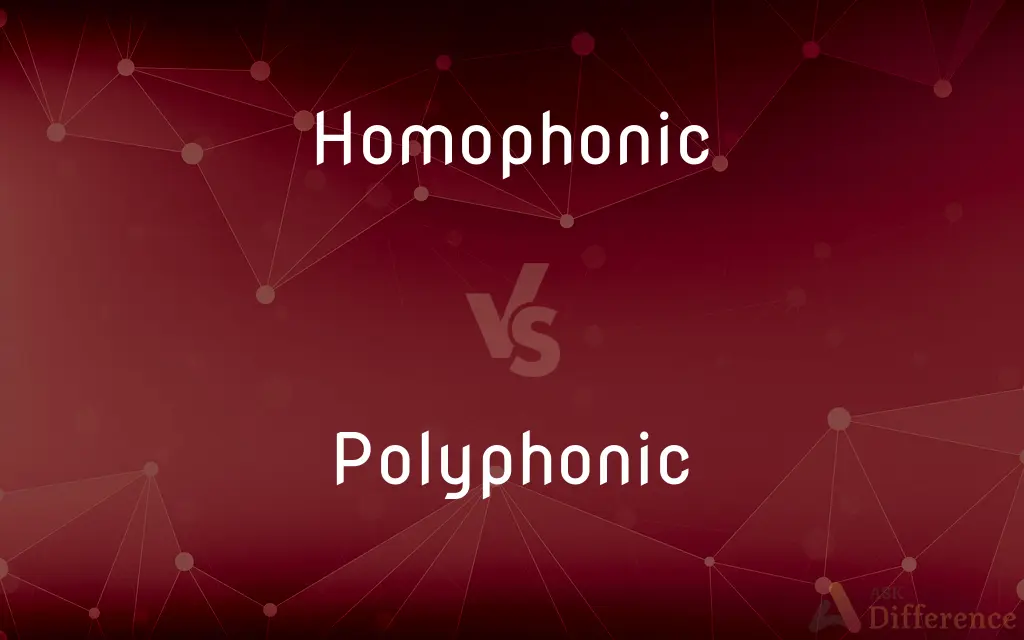Homophonic vs. Polyphonic — What's the Difference?
Edited by Tayyaba Rehman — By Urooj Arif — Updated on April 1, 2024
Homophonic music features a primary melody supported by chords, emphasizing harmony and texture, while polyphonic music consists of multiple independent melodies interwoven together, highlighting counterpoint and complexity.

Difference Between Homophonic and Polyphonic
Table of Contents
ADVERTISEMENT
Key Differences
In homophonic music, a clear, singular melody line is supported by accompanying chords or harmonies, creating a texture where the melody stands out prominently against a harmonic backdrop. Conversely, polyphonic music involves several melodies of equal importance played simultaneously, creating a rich, complex texture where no single melody dominates.
Homophonic texture is common in many forms of popular and classical music, where the focus is on the lyrical or main melodic line, often supported by chords played on instruments like the piano or guitar. On the other hand, polyphonic texture is characteristic of Baroque music and certain folk traditions, showcasing the intricate interplay between multiple independent lines.
While homophony tends to create a more straightforward and easily digestible musical structure, polyphony offers listeners a more intricate and layered auditory experience. The complexity of polyphonic music demands a higher degree of attentiveness from the listener to appreciate the nuances of the interwoven melodies.
In terms of compositional technique, homophony emphasizes harmony and the vertical aspect of music, focusing on how different notes and chords sound together at the same moment. Polyphony, however, emphasizes counterpoint and the horizontal relationships between melodies, focusing on how multiple melodies interact and develop over time.
The preference for homophonic or polyphonic textures varies across different musical genres and historical periods. Homophonic textures are often favored in genres that prioritize lyrical content and straightforward harmonies, whereas polyphonic textures are prized in genres and eras that value complexity and contrapuntal interaction.
ADVERTISEMENT
Comparison Chart
Texture
One main melody with chordal accompaniment
Multiple independent melodies
Focus
Harmony and melody
Counterpoint and complexity
Common in
Popular and classical music
Baroque music and certain folk traditions
Compositional Emphasis
Harmony and vertical aspect
Counterpoint and horizontal relationships
Listener Experience
Straightforward, melody-focused
Complex, layered auditory experience
Compare with Definitions
Homophonic
Music featuring a single melody with chordal accompaniment.
The song's homophonic texture highlighted the singer's voice beautifully.
Polyphonic
Relating to the interplay of several equal melodies.
The ensemble's polyphonic performance captivated the audience with its intricate layers.
Homophonic
Describes music focusing on chords supporting a melody.
The pianist chose a homophonic piece to showcase harmonic skills.
Polyphonic
Music consisting of multiple, independent melodies.
Bach's fugues are celebrated examples of polyphonic complexity.
Homophonic
A texture where melody and harmony are distinctly separate.
Classical sonatas often employ homophonic sections to emphasize lyrical melodies.
Polyphonic
Pertains to complexity and interaction in musical textures.
The quartet explored the nuances of a polyphonic piece, highlighting the skill of each musician.
Homophonic
Relating to music with one dominant melodic line.
Homophonic pieces are easier for audiences to follow due to their clear melodic direction.
Polyphonic
A texture where melodies intertwine without a dominant line.
Renaissance choral works often feature rich polyphonic textures.
Homophonic
Pertains to harmony and melody working together.
The choir's arrangement was predominantly homophonic, with all voices singing the same rhythm.
Polyphonic
Describes music emphasizing counterpoint.
Polyphonic compositions require performers to balance multiple melodic lines carefully.
Homophonic
Having the same sound.
Polyphonic
(Music) Of, relating to, or characterized by polyphony.
Homophonic
Having or characterized by a single melodic line with accompaniment.
Polyphonic
(Linguistics) Having two or more phonetic values.
Homophonic
(linguistics) Having the same sound; being homophones.
Polyphonic
Of or relating to polyphony
A polyphonic ringtone
Homophonic
(music) Having a single, accompanied, melodic line; not polyphonic.
Polyphonic
(music) having two or more independent but harmonic melodies; contrapuntal
Homophonic
Originally, sounding alike; of the same pitch; unisonous; monodic.
Polyphonic
(of an electronic device) able to play more than one musical note at the same time
Homophonic
Expressing the same sound by a different combination of letters; as, bay and bey.
Polyphonic
Of a text: capable of being read in more than one way.
Homophonic
Having the same sound
Polyphonic
Having a multiplicity of sounds.
Homophonic
Having a single melodic line with accompaniment
Polyphonic
Characterized by polyphony; as, Assyrian polyphonic characters.
Polyphonic
Consisting of several tone series, or melodic parts, progressing simultaneously according to the laws of counterpoint; contrapuntal; as, a polyphonic composition; - opposed to homophonic, or monodic.
Polyphonic
Having two or more phonetic values;
Polyphonic letters such as `a'
Polyphonic
Of or relating to or characterized by polyphony;
Polyphonic traditions of the baroque
Polyphonic
Having two or more independent but harmonically related melodic parts sounding together
Common Curiosities
Can a piece of music be both homophonic and polyphonic?
Yes, many compositions shift between homophonic and polyphonic textures to create contrast and interest.
Is homophonic texture common in modern music?
Yes, homophonic texture is prevalent in modern popular music, where a clear melody is often accompanied by chords.
Why is polyphonic music considered complex?
Polyphonic music's complexity arises from the interaction of multiple independent melodies, requiring careful listening to discern the interwoven lines.
What is homophonic texture in music?
Homophonic texture refers to music where a primary melody is supported by chordal accompaniment, emphasizing harmony.
How does polyphonic music differ from homophonic?
Polyphonic music features multiple independent melodies interwoven together, contrasting with homophonic music's focus on one melody with harmony.
What skills do musicians need for polyphonic music?
Musicians need advanced technical skills and a deep understanding of counterpoint to perform polyphonic music effectively.
How does one appreciate polyphonic music?
Appreciating polyphonic music involves active listening to understand how the independent melodies interact and complement each other.
How does homophonic music support vocalists?
Homophonic music supports vocalists by providing a clear harmonic foundation, allowing the vocal melody to stand out.
What is the main challenge in composing polyphonic music?
The main challenge is creating multiple independent melodies that are harmonically coherent and interesting when played together.
Can homophonic music be instrumental?
Yes, instrumental music can be homophonic, featuring a main melody accompanied by chords or harmonies.
What role does counterpoint play in polyphonic music?
Counterpoint is fundamental in polyphonic music, governing the relationship between the independent melodies to ensure musical coherence and interest.
What historical period is known for polyphonic music?
The Baroque period (approximately 1600-1750) is renowned for its complex polyphonic music.
Are there instruments particularly suited to polyphonic music?
Yes, instruments like the piano, organ, and harpsichord are well-suited for playing polyphonic music due to their ability to produce multiple notes simultaneously.
What genres favor polyphonic textures?
Genres such as classical, Baroque, and certain forms of jazz and folk music often favor polyphonic textures.
Why might a composer choose a homophonic texture?
A composer might choose a homophonic texture to highlight a melody, support lyrical content, or create a simple and accessible musical experience.
Share Your Discovery

Previous Comparison
Plump vs. Chubby
Next Comparison
Inheritable vs. HeritableAuthor Spotlight
Written by
Urooj ArifUrooj is a skilled content writer at Ask Difference, known for her exceptional ability to simplify complex topics into engaging and informative content. With a passion for research and a flair for clear, concise writing, she consistently delivers articles that resonate with our diverse audience.
Edited by
Tayyaba RehmanTayyaba Rehman is a distinguished writer, currently serving as a primary contributor to askdifference.com. As a researcher in semantics and etymology, Tayyaba's passion for the complexity of languages and their distinctions has found a perfect home on the platform. Tayyaba delves into the intricacies of language, distinguishing between commonly confused words and phrases, thereby providing clarity for readers worldwide.
















































